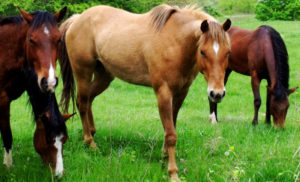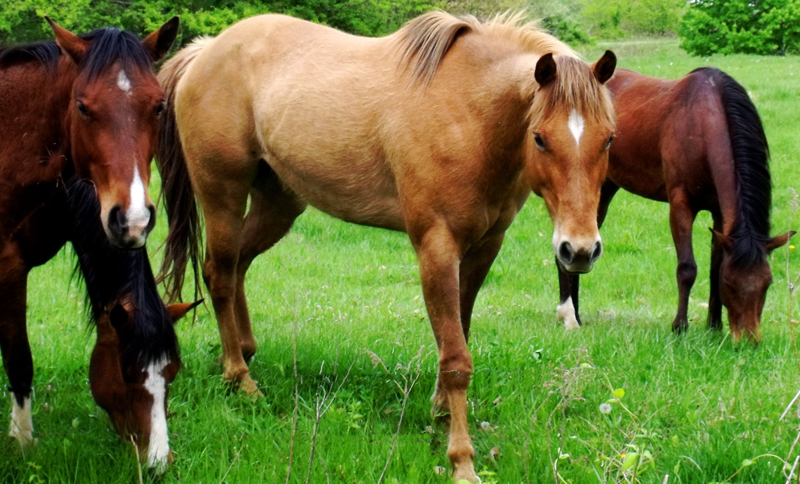The Care and Keeping of this Important Joint
by Paul Schwab, D.V. M.

Most horses at some time in their life will develop some amount of arthritis in one or more joints. The hock is one of the more common locations for arthritis. The hock in the horse is basically the same joint as the human ankle. It is comprised of 10 different bones and 4 joints. Two of the joints, the distal inter-tarsal and tarso-metatarsal joints are the two that tend to cause more problems with lameness and decreased performance.
As with other lameness issues in horses, conformation of the body and legs can predispose an animal to arthritis. Some hind limb conformations that may cause more problems include straight/upright hocks and sickle hocks (excessively angled hocks). These abnormal positions tend to cause uneven wear and tear on the joints and supporting soft tissues.
A horse’s occupation can also influence the degree and onset of hock arthritis as well. Some activities may cause more strain than others such as jumping, sliding, barrel racing, etc. Decreased performance is the typical complaint that riders will have when a horse is exhibiting hock pain. Jump refusal, increased time in speed events, and lead change issues are common problems. Actual lameness may be very mild and difficult to pick up and typically there is no swelling seen. Occasionally there may be firm swelling on the inside of the hock on more advanced cases.
When a horse is evaluated for any type of lameness an accurate and thorough history is needed. When is the horse lame? Does it get better after exercise? How long has it been a problem? Have you treated the horse with any medications? On a veterinary lameness exam we will spend time palpating or feeling the legs and back looking for any pain, swelling, or heat as well as watching the horse move at a walk, trot, and canter. Sometimes issues in other parts of the horse may be an indication of pain somewhere else. For example, horses with front limb or back issues may be compensating for hock problems. Flexion tests may give the best information about hocks. This test is so indicative of hock pain it is sometimes called a spavin test (Bone Spavin is a lay term for arthritis of the hock).
A presumptive diagnosis is usually made with the history, physical exam, and lameness exam. On more difficult cases, joint anesthesia may be needed to confirm pain in that location. A local anesthetic is injected into the joint and the horse reevaluated. If the lameness is better, the pain came from that joint. Results have to be interpreted carefully because anesthesia of the local soft tissues can occur. Once pain is isolated to the hock, radiographs should be taken to assess the severity of the arthritis, and to formulate a plan and prognosis. Radiographic changes in the hock can be very subtle, therefore four views are needed to give an accurate assessment. Radiographic signs may include decreased joint spaces, sharp growths on the edges of the bone, or areas of lysis (holes in the bone).
Treatment of hock arthritis is directed at reducing pain and inflammation. Non-steroidal anti-inflammatory drugs such as phenylbutazone(“bute”) are very effective at controlling pain and keeping horses comfortable, but must be given daily and may have drug withholdings at many competitions. Systemic treatment with substances that can improve cartilage and joint fluid quality such as polysulfated glycosaminoglycans (Adequan), hyaluronic acid (Legend), and oral glucosamine can be effective in some horses also. One of the most effective treatments for horses with hock arthritis is injection of the joints with corticosteroids and sometimes hyaluronic acid. This decreases the inflammation directly in the joint and can sustain pain relief longer than systemic NSAIDs.
Depending on the severity and location of the bony changes in the joint, fusion of the lower joints may be the best treatment option. The pain associated with arthritis is often the result of the damaged bone rubbing against bone. If the movement of the joint is stopped, there is less pain. Some horses will fuse on their own over time, especially with controlled exercise programs designed to hasten joint fusion. Newer therapies such as cold laser therapy and shockwave treatment may help in some cases and are very safe to the horse. Acupuncture and chiropractic treatments can be useful as supportive care, especially if there are secondary, compensation injuries.
Hock arthritis is a common problem of the aging horse, especially in the athlete. It doesn’t have to be career ending and there are a number of therapies available for most horses. Talk to your veterinarian or trainer if your horse is having performance issues.
Published December 2011 Issue

The Northwest Horse Source is an independently owned and operated print and online magazine for horse owners and enthusiasts of all breeds and disciplines in the Pacific Northwest. Our contemporary editorial columns are predominantly written by experts in the region, covering the care, training, keeping and enjoyment of horses, with an eye to the specific concerns in our region.






